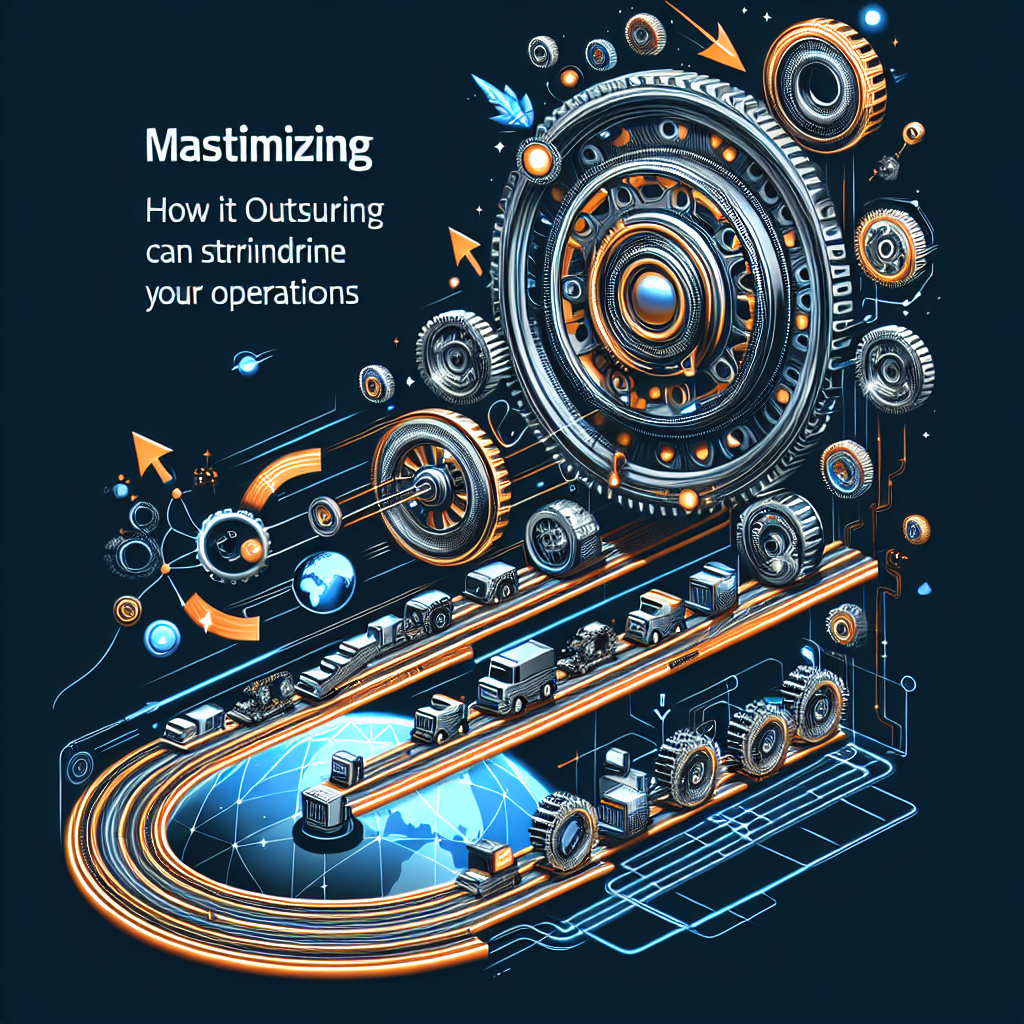Your cart is currently empty!
Tag: Efficiency

How IT Consulting Can Help Improve Your Company’s Efficiency
In today’s fast-paced business world, staying ahead of the competition requires constant innovation and optimization of processes. One way to achieve this is through IT consulting, a service that can help improve your company’s efficiency and streamline operations.IT consulting involves working with a team of experts who specialize in technology and business processes. These professionals can analyze your company’s current IT infrastructure, identify inefficiencies, and develop a customized plan to address them. By leveraging the latest technology and best practices, IT consultants can help your company operate more efficiently and effectively.
One of the key ways IT consulting can improve your company’s efficiency is by optimizing your IT systems. Outdated or inefficient systems can slow down operations and hinder productivity. IT consultants can assess your current systems and recommend upgrades or replacements that better meet your company’s needs. This can lead to faster processing times, improved data management, and enhanced security measures.
Additionally, IT consulting can help automate repetitive tasks and streamline processes. By implementing software solutions and workflows that eliminate manual work, your company can save time and resources. This allows employees to focus on more strategic tasks that drive innovation and growth.
IT consultants can also help improve communication and collaboration within your company. By implementing tools such as cloud-based file sharing and communication platforms, employees can work more effectively together, regardless of their location. This can lead to better teamwork, faster decision-making, and increased productivity.
Furthermore, IT consulting can help your company stay ahead of the curve when it comes to technology trends. By keeping up-to-date with the latest advancements in IT, consultants can recommend solutions that help your company remain competitive in the market. Whether it’s implementing artificial intelligence, machine learning, or blockchain technology, IT consultants can help you leverage these tools to improve efficiency and drive growth.
In conclusion, IT consulting can be a valuable resource for companies looking to improve their efficiency and competitiveness. By optimizing IT systems, streamlining processes, enhancing communication, and staying current with technology trends, IT consultants can help your company operate more effectively and achieve its business goals. If you’re looking to take your company to the next level, consider working with an IT consulting firm to unlock the full potential of your business.

Maximizing Efficiency with Remote Monitoring: Tips and Strategies for Success
In today’s fast-paced world, businesses are constantly looking for ways to improve efficiency and productivity. One way to achieve this is through remote monitoring, which allows companies to keep a close eye on their operations from anywhere in the world. By leveraging remote monitoring tools and strategies, businesses can streamline processes, identify potential issues early on, and ultimately maximize efficiency.Here are some tips and strategies for success when it comes to remote monitoring:
1. Invest in the right tools: To effectively monitor your operations remotely, you need to have the right tools in place. This could include sensors, cameras, software platforms, and other monitoring devices that allow you to track key metrics and performance indicators in real-time.
2. Set clear objectives: Before implementing a remote monitoring system, it’s important to define clear objectives and goals for what you want to achieve. Whether it’s improving production efficiency, reducing downtime, or enhancing the customer experience, having a clear vision will help guide your monitoring efforts.
3. Monitor key metrics: Identify the key performance indicators (KPIs) that are most important to your business and set up monitoring systems to track these metrics in real-time. This could include things like production output, equipment performance, energy consumption, and more.
4. Establish alerts and notifications: In order to respond quickly to any issues that arise, set up alerts and notifications for critical events. This could include things like equipment failures, deviations from set parameters, or other anomalies that require immediate attention.
5. Analyze data and trends: Remote monitoring generates a wealth of data that can provide valuable insights into your operations. Take the time to analyze this data, identify trends and patterns, and use this information to make informed decisions and improvements.
6. Implement preventive maintenance: By monitoring equipment performance and identifying potential issues early on, you can proactively address maintenance needs before they turn into costly downtime. Implementing a preventive maintenance program can help extend the life of your equipment and reduce the risk of unexpected failures.
7. Train and empower your team: Remote monitoring is only as effective as the people using it. Make sure your team is properly trained on the monitoring tools and systems in place, and empower them to take action based on the data and insights they gather.
By implementing these tips and strategies for success, businesses can maximize efficiency with remote monitoring. By leveraging the right tools, setting clear objectives, monitoring key metrics, establishing alerts, analyzing data, implementing preventive maintenance, and empowering your team, you can streamline operations, improve performance, and ultimately drive success.

Maximizing Efficiency with Managed Service Providers: Case Studies and Best Practices
In today’s fast-paced business world, maximizing efficiency is crucial to staying ahead of the competition. One way companies are achieving this is by partnering with managed service providers (MSPs) to handle their IT infrastructure and support needs. By outsourcing these tasks to experts in the field, businesses can focus on their core competencies and drive growth.Case studies have shown that companies who work with MSPs benefit from increased efficiency, improved productivity, and cost savings. One such example is a manufacturing company that partnered with an MSP to manage their network and security infrastructure. By outsourcing these tasks, the company was able to free up their internal IT team to focus on strategic projects, resulting in a 20% increase in productivity.
Another case study involves a healthcare provider that enlisted the help of an MSP to manage their electronic medical records system. The MSP was able to streamline the system, reduce downtime, and improve data security, leading to a 30% decrease in IT-related issues and a 15% increase in overall efficiency.
So, what are the best practices for maximizing efficiency with MSPs? Firstly, it’s important to clearly define your goals and expectations when partnering with an MSP. Communicate your needs and priorities upfront to ensure a successful partnership. Additionally, regularly review and assess the performance of your MSP to ensure they are meeting your needs and delivering on their promises.
Furthermore, it’s essential to have a strong relationship with your MSP and establish open lines of communication. By fostering a collaborative partnership, you can work together to address any issues or challenges that may arise and continuously improve efficiency.
In conclusion, partnering with managed service providers can help businesses maximize efficiency and drive growth. By outsourcing IT tasks to experts in the field, companies can focus on their core competencies and achieve better results. By following best practices and leveraging case studies, businesses can ensure a successful partnership with their MSP and reap the benefits of increased efficiency and productivity.

The Environmental Impact of Cloud Computing: Sustainability and Efficiency
Cloud computing has become an integral part of our daily lives, allowing us to access and store data and applications on remote servers instead of on our personal devices. While the benefits of cloud computing are clear – increased accessibility, cost savings, and scalability – the environmental impact of this technology is often overlooked.The environmental impact of cloud computing stems from the energy consumption of data centers that house servers and store the vast amounts of data that we generate and use every day. Data centers consume a significant amount of electricity to power and cool the servers, leading to a substantial carbon footprint. In fact, data centers are estimated to account for around 1% of global electricity consumption, and this number is expected to grow as the demand for cloud services continues to increase.
However, cloud computing also offers opportunities for sustainability and efficiency. By consolidating data and applications on shared servers, cloud providers can achieve economies of scale and reduce energy consumption compared to traditional on-premises data centers. Additionally, cloud providers are increasingly investing in renewable energy sources such as solar and wind power to power their data centers, further reducing their carbon footprint.
Another way that cloud computing can contribute to sustainability is through virtualization and resource optimization. By dynamically allocating computing resources based on demand, cloud providers can minimize energy consumption and reduce the need for additional hardware. This not only improves efficiency but also extends the lifespan of hardware, ultimately reducing electronic waste.
Furthermore, cloud computing enables remote work and telecommuting, which can help reduce greenhouse gas emissions from commuting and office buildings. By allowing employees to work from anywhere, cloud computing can help organizations reduce their carbon footprint and promote a more sustainable work environment.
In conclusion, while cloud computing does have an environmental impact, it also offers opportunities for sustainability and efficiency. By leveraging renewable energy sources, optimizing resource allocation, and promoting remote work, cloud providers can reduce their carbon footprint and contribute to a more sustainable future. As consumers and businesses increasingly rely on cloud services, it is important for cloud providers to prioritize sustainability and invest in environmentally-friendly practices to minimize their impact on the planet.

Maximizing Efficiency: How IT Outsourcing Can Streamline Your Operations
In today’s fast-paced business environment, maximizing efficiency is crucial for staying competitive and meeting customer demands. One way to achieve this is through IT outsourcing, which can streamline your operations and improve overall productivity.IT outsourcing involves hiring external IT service providers to handle certain aspects of your business’s technology needs. This can include managing software development, network maintenance, cybersecurity, and more. By outsourcing these tasks, you can free up internal resources and focus on core business activities.
One of the key benefits of IT outsourcing is the ability to access specialized expertise. IT service providers often have a team of skilled professionals with years of experience in various technologies and industries. This means they can quickly and efficiently address any IT issues that arise, minimizing downtime and ensuring smooth operations.
Outsourcing IT services also allows your business to stay up-to-date with the latest technology trends. IT service providers are constantly monitoring the market for new developments and innovations, and can help you implement cutting-edge solutions that improve efficiency and drive growth.
Additionally, outsourcing IT services can help reduce costs. By hiring external providers, you can avoid the expenses associated with hiring and training internal IT staff, as well as investing in expensive hardware and software. This can result in significant cost savings for your business.
Furthermore, outsourcing IT services can improve scalability and flexibility. As your business grows, you can easily scale up or down your IT services to meet changing demands. This flexibility allows you to adapt quickly to market changes and stay ahead of the competition.
Overall, IT outsourcing can streamline your operations and maximize efficiency in several ways. By leveraging specialized expertise, staying current with technology trends, reducing costs, and improving scalability, outsourcing IT services can help your business achieve its goals and drive success in today’s competitive marketplace.

Maximizing Efficiency with Managed Service Provider Solutions
In today’s fast-paced business world, companies are constantly looking for ways to increase efficiency and productivity. One way to achieve this is by utilizing managed service provider solutions. Managed service providers (MSPs) offer a range of services that can help businesses streamline their operations and free up valuable resources.One of the key benefits of working with an MSP is the ability to outsource IT tasks and responsibilities. Many businesses struggle to keep up with the rapidly changing technology landscape, and managing IT infrastructure can be a daunting task. By partnering with an MSP, companies can offload the day-to-day management of their IT systems, allowing them to focus on core business activities.
Managed service providers also offer proactive monitoring and maintenance services, which can help prevent costly downtime and ensure that systems are running smoothly. This can help businesses avoid the headaches and financial losses associated with unexpected IT issues.
Another advantage of working with an MSP is access to a team of highly skilled professionals. MSPs typically employ experts in various technology areas, including networking, cybersecurity, and cloud computing. This means that businesses can benefit from the expertise of these specialists without having to hire and train in-house staff.
Additionally, MSPs can offer cost-effective solutions that can help businesses save money in the long run. By leveraging the economies of scale that come with managing multiple clients, MSPs can often provide services at a lower cost than businesses would incur if they were to manage their IT systems internally.
Overall, working with a managed service provider can help businesses maximize efficiency in several ways. By outsourcing IT tasks, businesses can focus on their core activities, while benefiting from proactive monitoring and maintenance services, access to a team of experts, and cost-effective solutions. In today’s competitive business environment, partnering with an MSP can give companies a competitive edge and help them stay ahead of the curve.

Maximizing Efficiency: How IT Consulting Can Improve Your Business Operations
In today’s fast-paced business world, maximizing efficiency is key to staying ahead of the competition. One way to achieve this goal is through IT consulting services. By partnering with a team of experts in information technology, businesses can streamline their operations, reduce costs, and increase productivity.IT consulting can help businesses identify and eliminate inefficiencies in their systems and processes. By conducting a thorough assessment of the company’s current IT infrastructure, consultants can pinpoint areas that are causing bottlenecks or hindering workflow. They can then recommend and implement solutions to address these issues, such as upgrading software, implementing new technologies, or reorganizing workflows.
In addition to identifying and solving existing problems, IT consultants can also help businesses plan for future growth and expansion. By staying abreast of the latest trends and technologies in the industry, consultants can advise businesses on the best strategies to adopt to keep pace with changing market demands. This proactive approach can help businesses stay ahead of the curve and be prepared for any challenges that may arise.
Furthermore, IT consulting can help businesses reduce costs by optimizing their IT spending. Consultants can help businesses identify areas where they can cut costs, such as consolidating services, renegotiating contracts, or implementing more efficient processes. By reducing unnecessary expenditures and maximizing the value of their IT investments, businesses can improve their bottom line and increase profitability.
Another benefit of IT consulting is that it can help businesses improve their cybersecurity measures. With the increasing threat of cyber attacks and data breaches, it is more important than ever for businesses to have robust security measures in place. IT consultants can assess a company’s current security posture and recommend solutions to strengthen their defenses, such as implementing encryption technologies, establishing secure access controls, and conducting regular security audits.
Overall, IT consulting can be a valuable asset for businesses looking to maximize efficiency and improve their operations. By partnering with a team of experts in information technology, businesses can identify and eliminate inefficiencies, plan for future growth, reduce costs, and enhance their cybersecurity measures. With the help of IT consulting services, businesses can stay competitive in today’s rapidly evolving business landscape.

Maximizing Efficiency with IT Solutions
In today’s fast-paced and competitive business environment, efficiency is key to staying ahead of the game. One of the most effective ways to maximize efficiency in your organization is by implementing IT solutions that streamline processes, automate tasks, and improve overall productivity.IT solutions encompass a wide range of technologies and systems that are designed to help businesses operate more efficiently and effectively. From cloud computing and data analytics to customer relationship management (CRM) software and project management tools, there are countless IT solutions available to help companies optimize their operations.
One of the most popular IT solutions for maximizing efficiency is cloud computing. By storing data and applications in the cloud, businesses can access information from anywhere at any time, allowing for greater flexibility and collaboration among team members. Cloud computing also reduces the need for physical storage space and can lower IT costs in the long run.
Data analytics is another powerful IT solution that can help businesses make more informed decisions and improve overall efficiency. By analyzing large volumes of data, companies can uncover valuable insights and trends that can drive strategic decision-making and improve business processes. Data analytics can also help organizations identify areas for improvement and optimize performance across various departments.
CRM software is another essential IT solution for maximizing efficiency. By centralizing customer data and streamlining communication with clients, CRM software can help businesses better understand their customers’ needs and preferences, resulting in improved customer satisfaction and retention. CRM software also helps organizations track sales leads, manage marketing campaigns, and automate routine tasks, saving time and resources in the process.
Project management tools are also key IT solutions for maximizing efficiency in organizations. By providing a centralized platform for planning, tracking, and monitoring projects, project management tools help teams stay organized and on track to meet deadlines and deliverables. These tools also enable effective collaboration among team members, leading to increased productivity and better project outcomes.
In conclusion, IT solutions play a crucial role in maximizing efficiency in today’s business world. By leveraging technologies such as cloud computing, data analytics, CRM software, and project management tools, organizations can streamline processes, automate tasks, and improve overall productivity. Investing in IT solutions is a smart decision for businesses looking to stay competitive and achieve long-term success in today’s digital age.

How Remote Monitoring Can Improve Efficiency in Healthcare
In the fast-paced world of healthcare, efficiency is key. Healthcare providers are constantly looking for ways to streamline processes and improve patient care. One way that technology is helping to achieve this goal is through remote monitoring.Remote monitoring allows healthcare providers to keep track of patients’ vital signs and health data from a distance. This can be especially helpful for patients with chronic conditions or those who require ongoing monitoring. By using remote monitoring devices, healthcare providers can receive real-time data on a patient’s health status, allowing for quicker intervention when necessary.
One of the biggest benefits of remote monitoring is that it allows for more proactive and personalized care. Instead of waiting for a patient to come in for a check-up or waiting for symptoms to worsen, healthcare providers can monitor patients on an ongoing basis and make adjustments to their care plan as needed. This can lead to better outcomes for patients and can help prevent unnecessary hospitalizations or emergency room visits.
Remote monitoring can also improve efficiency in healthcare by reducing the need for in-person visits. This can be especially beneficial for patients who live in remote areas or have mobility issues. Instead of traveling to a healthcare facility for a routine check-up, patients can simply use a remote monitoring device to track their health data and communicate with their healthcare provider as needed. This can save time and money for both patients and healthcare providers.
In addition, remote monitoring can help healthcare providers better manage their caseload. By receiving real-time data on patients’ health status, providers can prioritize care for those who need it most and allocate resources more effectively. This can help prevent burnout among healthcare providers and ensure that patients receive the care they need in a timely manner.
Overall, remote monitoring is a powerful tool that can improve efficiency in healthcare and enhance patient care. By using technology to monitor patients remotely, healthcare providers can provide more proactive and personalized care, reduce the need for in-person visits, and better manage their caseload. As technology continues to advance, remote monitoring is likely to become an increasingly important part of healthcare delivery, helping to improve outcomes for patients and streamline processes for providers.

Maximizing Efficiency: How Cloud Computing is Transforming IT Infrastructure
In today’s fast-paced digital world, businesses are constantly looking for ways to maximize efficiency and streamline their operations. One of the key technologies that is transforming the way IT infrastructure is managed is cloud computing. Cloud computing allows businesses to access computing resources over the internet, rather than relying on physical servers and infrastructure.By moving their IT infrastructure to the cloud, businesses can realize a number of benefits that can help them operate more efficiently. One of the key advantages of cloud computing is scalability. With cloud computing, businesses can easily scale up or down their computing resources based on their needs. This means that businesses can quickly adapt to changing demands without having to invest in expensive hardware or infrastructure.
Another key benefit of cloud computing is cost savings. By moving to the cloud, businesses can reduce their IT infrastructure costs, as they no longer need to invest in physical servers and other hardware. Additionally, businesses can benefit from pay-as-you-go pricing models, which means they only pay for the computing resources they actually use.
Cloud computing also allows businesses to improve their flexibility and agility. With cloud computing, businesses can access their data and applications from anywhere, at any time, using any device. This flexibility allows businesses to quickly respond to changing market conditions and customer demands.
Security is another important consideration when it comes to IT infrastructure. Many businesses are concerned about the security of their data when moving to the cloud. However, cloud computing providers invest heavily in security measures to ensure that their customers’ data is protected. By leveraging the security expertise of cloud providers, businesses can ensure that their data is safe and secure.
Overall, cloud computing is transforming IT infrastructure by enabling businesses to operate more efficiently, reduce costs, improve flexibility and agility, and enhance security. By leveraging the power of cloud computing, businesses can stay ahead of the competition and drive innovation in today’s digital economy.
